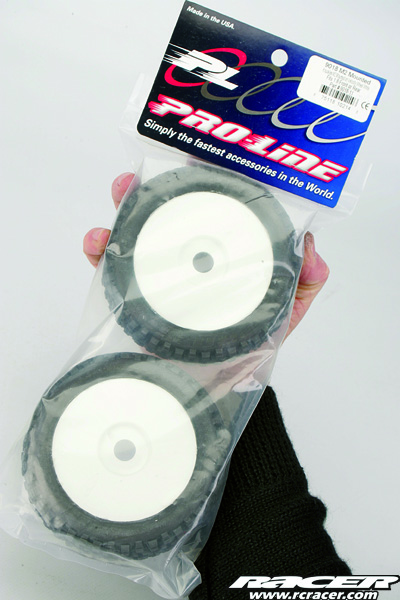Sticking Together
Gluing on tyres may sound easy, but plenty of races have been lost by drivers not making sure their tyres were properly attached. So here’s our guide to the best way of ensuring your valuable rubber stays stuck to your wheels.
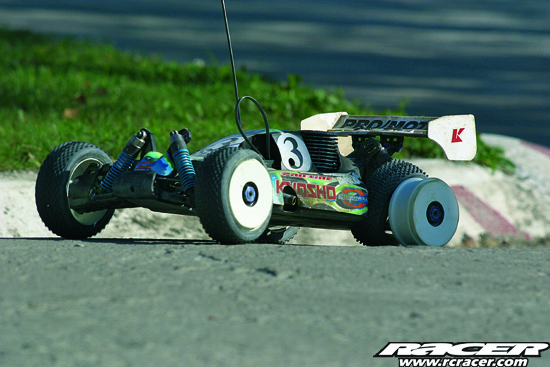
Health and Safety
When using superglue, particularly the very runny lightweight variety, always handle with great care. Use the glue sparingly, wear some eye protection, and avoid getting the glue on your fingers or clothing. It is also a good idea to carry a bottle of superglue release agent in your pit-box in case of emergencies.
The most important components on any RC car are the tyres. They are not only what keeps the car in contact with the ground, they are also an essential ingredient for fine tuning its handling. Keeping them stuck to the track is one thing, but keeping them stuck to the wheels is quite another.
With the amount of power available and the high cornering speeds of today’s RC cars, the tyres are under an immense amount of pressure with the forces involved constantly trying to pull them off the rims. Therefore making sure they’re glued firmly on the wheels is vital, so here’s our step-by-step guide to successful tyre building. Although our guide shows you how to glue 1:8 off-road tyres, the principles are the same whatever your car, b it a touring car, right through to monster trucks.
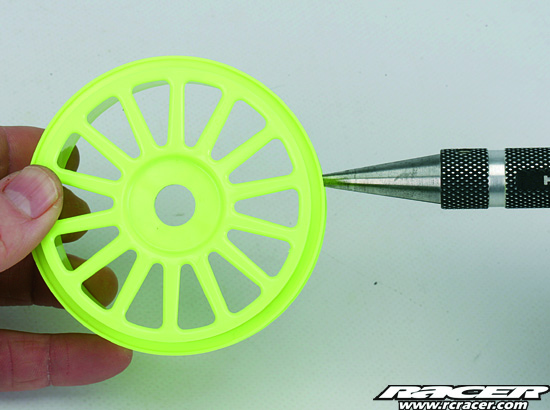
Drill wheels – Two small holes should first be drilled at the top and bottom or each wheel using a small drill or reamer. As the tyres are semi-pneumatic the holes allow them to enlarge and deflate during use as air is pushed in and out of the tyre and insert. This helps the tyre to make good contact with the track surface and so increases traction.
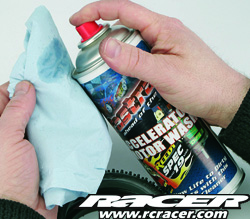
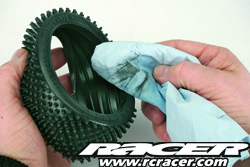
Clean rims and tyres – Both the plastic wheel rims and rubber tyres are coated with a chemical releasing agent. This is deposited during the manufacturing process and must be removed if the glue is to achieve a strong bond. Use some solvent such as motor spray or lighter fluid on a tissue or rag to clean this residue from both the wheel rims and tyre beads. It may be worth testing a small area first to make sure the solvent used doesn’t react with either the plastic or rubber.
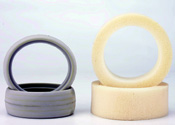
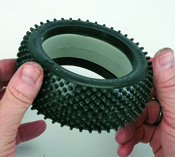
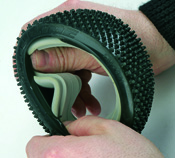
Add insert – Some tyres are supplied with an insert, but if they’re not you will have to choose which one to use. Just like tyres, these are available in a range of different compounds. A soft insert will make the assembled tyre feel softer and should increase available grip, but this may also make the tyre wear faster. Alternatively a harder insert will stop the tyre from deforming quite so much therefore reducing grip and also the wear rate. Once you’re happy with your chosen insert fit it into the tyre and make sure it’s seated properly all the way round.
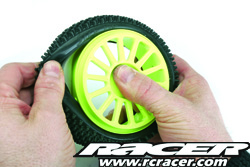
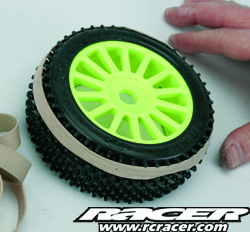
Fit the tyre – Now take the tyre and insert and carefully stretch them over the wheel. Try to do this as smoothly as possible to avoid twisting or unseating the insert. Once the tyre is completely on the wheel go all the way around the rim and make sure the bead of the tyre is pushed into the moulded grooves on the edge of the wheel. Once you’re happy with the fitting, just go round the whole assembly and check everything seems seated correctly and that the tyre is round and there are no flat spots or high points.
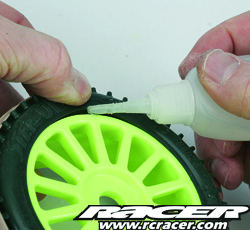
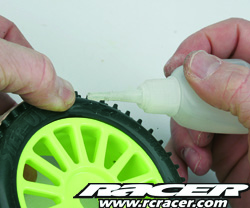
Glue on – The tyre is now ready for gluing. Always use a good quality cynoacrylate adhesive, which is better known as superglue. Lighter weight superglue is easier to run around the edges and will also dry much faster than a thicker variety, but care must be taken not to use too much or let the glue run over and onto the tyre surface. To start with lift up a small portion of the tyre bead on one side and drop in a small amount of superglue. Then push the bead firmly back into place and allow it to dry for a few seconds before repeating the process all the way round the tyre. Remember that when it comes to using the superglue, less is definitely more. If you do accidentally get some glue on the tyre tread, don’t panic. Let it dry and then use some sandpaper or a Dremel fitted with a small sanding drum to remove the excess glue.
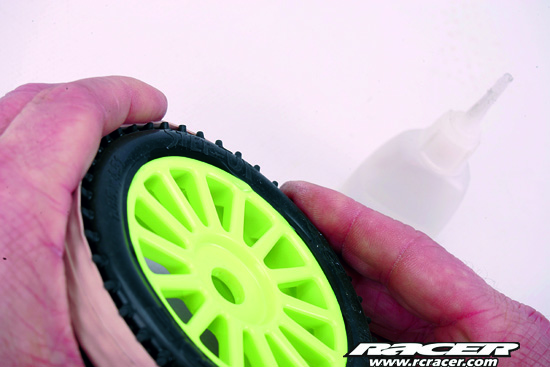
Check edges – Once you’ve glued the tyre all the way round leave it to dry while you tackle the next one. Then go back to the first one and glue up the other side, and so on until both sides of all four tyres have been glued. As the light superglue dries quite quickly you should be able to now go back to the first tyre to inspect your handywork. Check that the tyre is properly seated and secure all the way round. For added security you can now very carefully put a small drop of superglue on the tyre sidewall where it meets the rim and let it run all the way round to seal the edge.
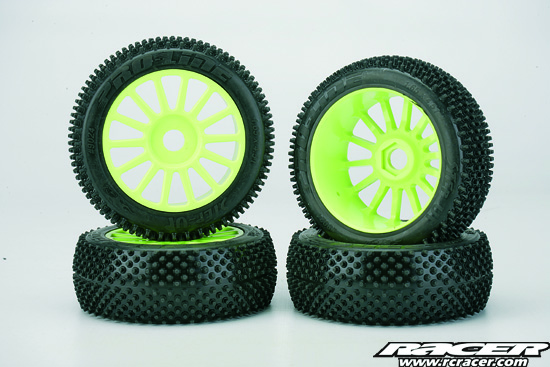
Leave to dry – Now leave all the tyres in a warm dry place to allow the glue to cure properly. If you are gluing tyres at the track between races you should be able to use them straight away, but if possible try and build your tyres the night before you really need them as this will allow the glue plenty of time to set and lessen the chance of a tyre coming off in a race.
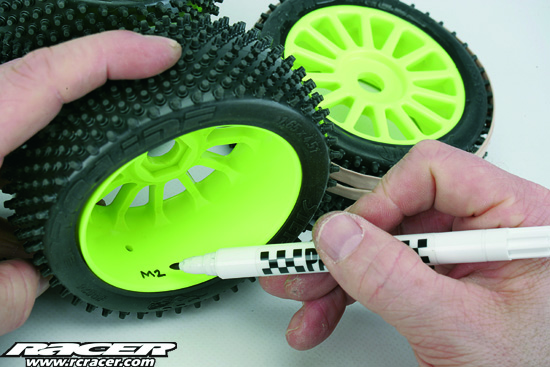
Mark the wheels – So that you can remember what tyre compound and insert combination is mounted on the wheel, use a fine permanent marker pen to write it on the wheel. One tip used by some of the top drivers if they don’t want others to know what tyres they’re running is to write this information inside the wheel hex in the centre. You’ll have to write very small, but once the wheels are fitted on the car, no-one will know what tyres you’re using.
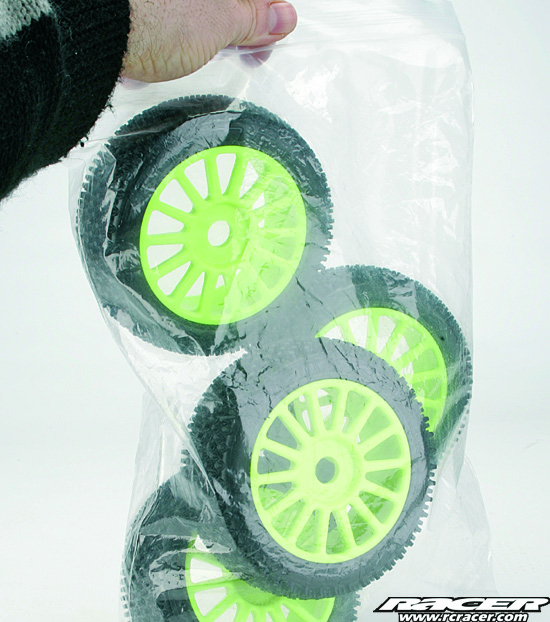
Use or store – If you’ve built the new tyres up at the track, you may be intending to use them straight away. If you’ve glued them at home and won’t be using them for a while the best way to store them is in a sealed plastic bag. Re-sealable freezer bags available from the supermarket are ideal and will stop the rubber drying out. Your brand new tyres are now ready for use.
Pre-Glued Tyres
If all this seems like hard work, then it is now possible to buy most popular compounds of tyre pre-glued on wheels. These are bonded firmly to the rims using special gluing processes at the factory that are extremely strong and reliable. Using these saves a lot of time and effort and when you take the separate costs of wheels, inserts, tyres and glue into consideration they are also very good value for money. In fact in an effort to cut costs and even up competition, the BRCA Touring Car Championship is only allows the use of pre-glued tyres as do many other on-road series.
